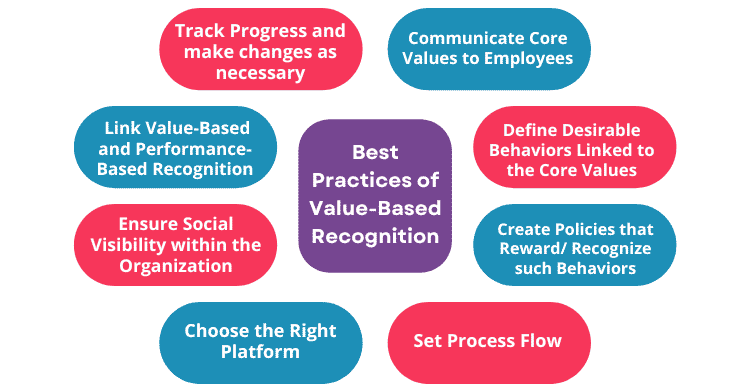1. Value-based recognition, or rewarding employees for behaviors that reflect an organization’s core values, is a critical element in fostering a positive organizational culture.
2. This approach enhances employees’ sense of purpose and belonging, resulting in increased engagement and satisfaction.
3. To implement value-based recognition effectively, organizations should communicate core values, define desirable behaviors, create appropriate policies, and ensure social visibility within the company.
4. A key factor in fostering a positive organizational culture is striking a balance between value-based and performance-based recognition.
5. This balance allows employees to thrive and feel appreciated for their adherence to core values and performance.
In recent times, organizations have become aware of the long-term benefits of value-based recognition, shifting their focus from solely emphasizing employee performance, achievements, or tenure in employee recognition.

Value-based recognition can simply be defined as a recognition strategy in which organization reward and recognize their employees for any exemplary behavior that reflects the core values of the organization.
The organization designs the recognition programs to reinforce and drive business goals, empower employees, and foster a positive employer brand.

Millennials today comprise a significant percentage of the global workforce, and this trend is likely to continue.
This has changed the expectations of employees from their workplace, with most of them seeking a sense of greater meaning and purpose.

It is in contrast to the mere benefits and perks sought by earlier generations.
Value-based recognition provides employees with a sense of meaning and purpose, thereby strengthening their sense of belonging and engagement.

Value-based employee recognition focuses more on the process than the results.
When employees focus on honoring the core values of the organization, it naturally results in the achievement of the desired results.
This type of recognition also tends to have a positive impact on the relationship between managers and employees.
It makes the employees feel happier and more satisfied with their contribution to the overall mission of their organization.

At a large insurance company, any employee can spontaneously recognize any other employee for demonstrating the organization’s core values using the HiFives recognition platform.
Employees can recognize their coworkers using the HiFives web app, mobile app, or WhatsApp chatbot without intervention from their managers or the HR team.
The employees can receive recognition for any of the nine core values of the organization:
1. Integrity
2. Commitment
3. Passion
4. Seamlessness
5. Speed
6. Agility
7. Innovation
8. Collaboration
9. Focus and Result-orientation
The recipient of the recognition will instantly receive a personalized e-certificate via email and WhatsApp. The reporting manager and immediate team members of the recipient also receive notifications about the recognition.
The recognition posts appear on the HiFives platform’s social wall, where other coworkers can see it, like it, and offer congratulations to the recipient.
The top winners of such value-based recognition receive reward points at the end of each month. They can redeem these points for e-gift cards on the HiFives platform.
The primary objective of value-based recognition programs is to create a culture of respect, recognition, and appreciation for employees across all levels.
Organizations can consider the following best practices while implementing such recognition programs for their workforce:
1. Communicate Core Values to Employees
2. Define Desirable Behaviors linked to the Core Values
3. Create Policies that Reward/recognize such Behaviors
4. Set Process Flow
5. Choose the Right Platform
6. Ensure Social Visibility within the Organization
7. Link Value-Based and Performance-Based Recognition
8. Track Progress and Make Changes as necessary


Every organization operates with a particular set of values that it expects its employees to follow and adapt.
To fulfill this objective, organizations need to ensure that their employees are well aware of these core values that are key to their mission and culture.
Recognizing employees for their contributions to promoting these core values empowers them to do so.

While communicating core organizational values to the employees is the first step, the next step is to define the desirable behaviors linked to them.
It helps clarify how employees are likely to behave to uphold these values.
Such clarity is essential for creating a culture of mutual understanding, respect, and dedication.

Organizations need to devise the right policies to reward and recognize the desirable behaviors defined earlier.
Rewarding behaviors associated with core values immediately is more important than how employees receive the rewards..

As important as it is to reward the employees for desirable behaviors, defining the right process flow is equally important.
It essentially means determining who can nominate the recipients, who can offer the rewards with what type of recognition, and other aspects besides promoting peer-to-peer and top-down recognition.

Investing in the right employee recognition platform is crucial for successfully implementing a value-based recognition program.
Such platforms offer the right features and functionality to tie the core organization values with desirable behaviors.
They also incorporate the best ways of recognizing such behaviors.
Most importantly, such platforms help maintain the transparency and integrity of the rewards program.

Organizations should ensure that every time an employee receives value-based recognition, the other members of the workforce are made aware of the same.
Publishing such recognition on internal communication and collaboration platforms such as the Intranet, Microsoft Teams, Yammer, and Slack is a great way to do so.
It can help motivate and inspire other employees to emulate the recipients’ actions.

While promoting value-based recognition is essential, it should not be at the cost of ignoring performance-based recognition.
Organizations need to create a balance between both these types of recognition to create a healthy and balanced organizational culture where their employees can thrive.

Finally, it is important to track the progress of the value-based recognition program from time to time and make any necessary changes to it.
It is essential to stay updated with the changing needs and expectations of the workforce in response to shifting market trends.
Developing an effective value-based recognition program helps in clarifying, aligning, and reinforcing the organization’s vision and its expectations from its employees; keeping them motivated and focused.

Lead author: Sagar Chaudhuri, the Co-Founder and CEO of HiFives. He is an HR Tech Evangelist with over 25 years of experience in both corporate and entrepreneurial settings. Previously, Sagar has held leadership roles with companies such as Genpact, Infosys, and ICICI Bank. He has an engineering degree from IIT Kharagpur and an MBA from IIM Lucknow. Connect on LinkedIn
To stay updated on the latest HiFives blogs, follow us on Twitter (@MyHiFives)